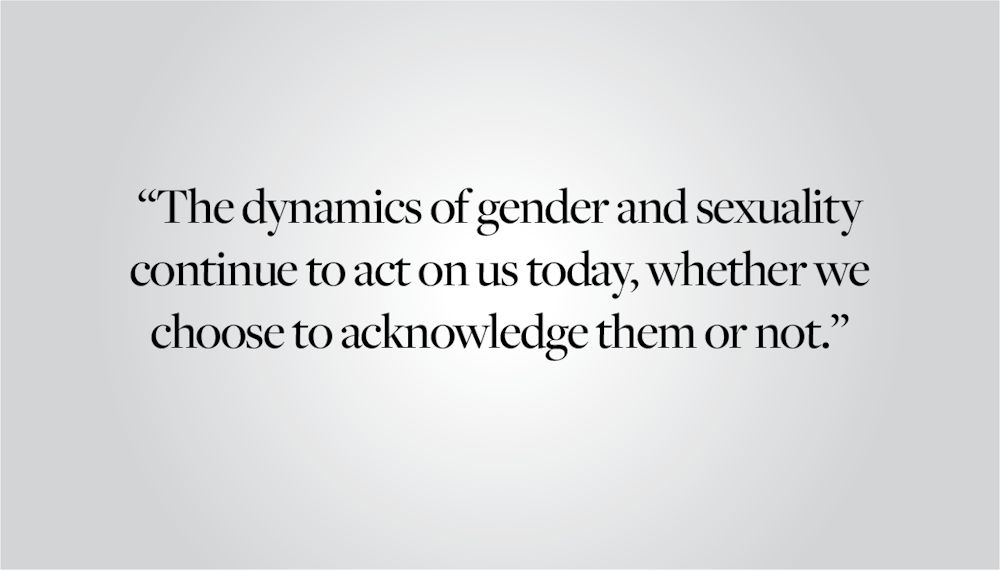You’ve probably passed them dozens of times on a rushed walk to Andrews Commons or after a class in Smith-Buonanno Hall — the stone plaque by the flowerbeds and the seal that many students still avoid out of superstitious habit. These little monuments are tributes to a significant period of Brown’s history: when Pembroke Campus was once Pembroke College — and when women at Brown did not always fit so seamlessly into campus life. Beyond the physical imprints on North Campus, it’s also possible to draw on the rich legacy of Pembroke College through University archives. One such collection, the Pembroke Center Oral History Project, contains recorded interviews with dozens of female and nonbinary alumni from Pembroke College and Brown University across the 20th and 21st centuries. In its careful observation of the past, the Oral History Project becomes an invaluable resource when confronting questions about what it means to negotiate gender, identity and community on campus today. The conversations with the women of Brown and Pembroke show us that, even as educational disparities lessen on campus, gender-based communities remain as valuable today as they were a century ago and require just as active cultivation.
Pembroke College — formerly known as the Women’s College — educated female students from 1891 until 1971, when classes and dormitories at Brown finally became coeducational. Since the late 1900s, archivists at the Pembroke Center have conducted interviews with women whose lives span a majority of the College’s legacy, including alumni who graduated as long ago as 1911. Some of their descriptions of student life feel nothing short of otherworldly — memories of shirtwaists and full skirts and orchestras that played “The Star Spangled Banner” in Alumnae Hall. Pembroke alumni also described their academic experiences, recounting the moments when math and science departments opened their classes to women for the first time, and how their education shaped their post-grad lives.
The oral histories also reveal something alive and tender at the heart of each alumna’s memory of their undergraduate life — an account of what it meant to attend a women’s college during a century that saw radical changes in social and political ideas about gender. Pages of transcripts were filled with vivid descriptions of communal, female experiences amongst students at Pembroke — ones that seemed to transcend class years. Helen, class of 1922 spoke of dancing with hallmates to jazz music in Miller Hall in the early mornings and “haul(ing) single bed mattresses onto the fire escape” to sleep outdoors in the spring. Mary Jane ’56 fondly recalled the warmth of the women in the co-operative who supported her as she became the first Pembroke student to pursue engineering at Brown. And Penelope ’68 described the solidarity she felt with the five fellow Black women in her class as they witnessed the influence of the civil rights movement and women’s revolution on campus and formed the University’s Afro-American society — all while Pembroke underwent a process of integration into Brown. Often unprompted, the women in these interviews spoke longly and fondly about the sororities, singing groups and activist organizations they participated in while at Pembroke.
It is not surprising, then, that in 2023 there is a similar eagerness amongst students to articulate how groups oriented around gender have shaped their college experience. Hannah Dunn ’23, a member of Alpha Chi Omega and Brown Women’s Pre-Law Society, described the comfort she gained from relationships with female mentors, particularly when she was a first-year. She asserted that there is “something about being in a community of women that's very empowering and nourishing.” Dunn further connected the value of her sorority with her experience in groups for students of color on campus, noting how special it is to “share space only with people that share a similar background and identity with you, because there's just an experience of life that they can just understand without being told.” Crystal Banh ’25 works to foster that same sense of understanding and visibility among non-male students as a Women Gender & Sexuality Peer Counselor at the Sarah Doyle Center, which she refers to as a second home. Banh and her fellow WGSPCs organize book groups, zine-making workshops and conversations about current events. In creating traditions centered around identity, she has discovered and fostered a particular form of joy amongst people who “care about the same things I do.”
There are some who might say that we’ve outgrown the need for the same kinds of gendered spaces that existed in the 1920s and ’50s — that they are unnecessary or even outdated at a modern, coeducational university. After all, it’s easy to move from the classroom to the dining hall to the dorm amongst bodies of all genders and subsequently believe that no gender is at work. But, as Banh notes, the dynamics of gender and sexuality continue to act on us today, whether we choose to acknowledge them or not. Our ideas about femininity, masculinity and sexuality have become much broader than the cisgender and heterosexual narrative that dominated the 1900s. Sarah Doyle and Stonewall House create spaces for women, trans and nonbinary students to come together in ways not possible fifty or eighty years ago. But this evolution will only continue to be possible if we consciously assert the value of those spaces and seek out people with whom we can be our most visible selves. The conversations we have about womanhood and gender identity will inevitably shift over the years, but the underlying importance of dedicating time, resources and attention to them is constant. Students at Brown should view Pembroke, and the oral histories of the women who studied there, not as a relic of the far past, but as a reminder of what we might recount about our time at Brown decades from now — and what forces we will choose to shape it.





